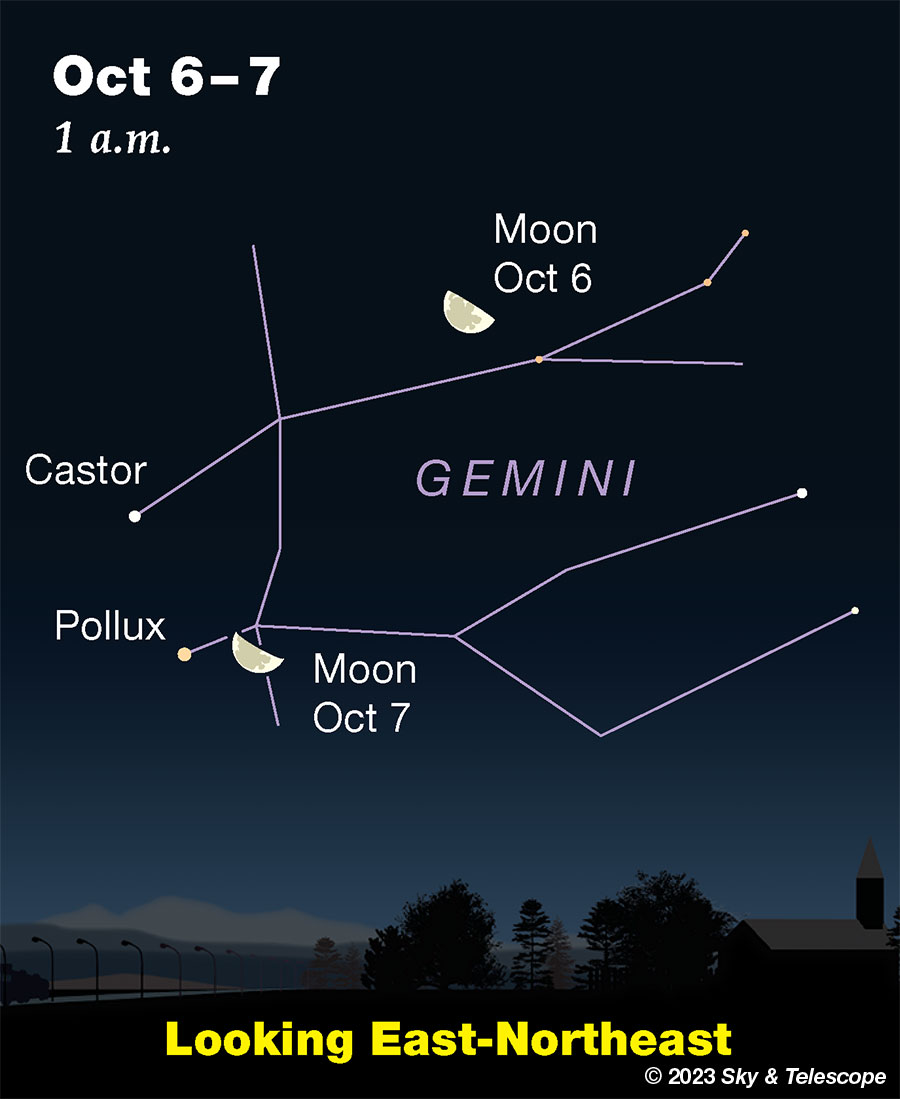Special to CosmicTribune.com, October 3, 2023
Excerpts from weekly Sky&Telescope report.
SUNDAY, OCTOBER 1
■ The waning gibbous Moon rises in the east-northeast around the end of twilight. Ten or fifteen minutes later, Jupiter rises just 2° or 3° to the Moon’s lower right. Later in the evening the two shine high, as shown below.
These are currently the two brightest objects in the entire evening sky, from horizon to horizon. What are the odds that the two brightest objects in that whole expanse would appear so close together?
 MONDAY, OCTOBER 2
MONDAY, OCTOBER 2
■ Now the Moon shines only about 2° from the Pleiades. The moonlight may nearly wipe out the Pleiades for the unaided eye.
TUESDAY, OCTOBER 3
■ After dark, Vega is the brightest star very high west of the zenith after dark. Face west and look up at it.
The main stars of Vega’s own constellation, Lyra — also pretty faint — extend 7° from Vega on the side opposite Draco’s head.
WEDNESDAY, OCTOBER 4
■ Once the waning gibbous Moon is up in good view in late evening, you’ll notice that it’s on the line from Aldebaran at its lower right to Capella more than twice as far to the Moon’s upper left.
THURSDAY, OCTOBER 5
■ This is the time of year when the rich Cygnus Milky Way crosses the zenith right after nightfall is done (for skywatchers at mid-northern latitudes). The Milky Way extends straight up from Sagittarius in the low southwest, passes overhead, and runs straight down through Cassiopeia and Perseus in the northeast.
■ Arcturus shines in the west as twilight fades away. Capella, equally bright, is rising in the north-northeast (depending on your latitude; the farther north you live the higher it will be.) They’re both magnitude 0.
That bright light more than a third of the way from Capella to Fomalhaut is, of course, Jupiter.
Higher above Fomalhaut glows Saturn, pale yellow and steady.
FRIDAY, OCTOBER 6
■ Last-quarter Moon tonight (exactly so at 9:48 a.m. on the morning of the 6th). The Moon rises around 11 p.m., and by two hours later on the morning of the 6th it’s shining well up just above the stick figure of Castor as shown below.

The last-quarter Moon awaits night owls, as it hangs over late-rising Gemini.
SATURDAY, OCTOBER 7
■ The Great Square of Pegasus balances on its corner high in the east at nightfall.
SUNDAY, OCTOBER 8
■ Cygnus the Swan, with Deneb as its tail, floats straight overhead after nightfall. Its brightest stars form the big Northern Cross.
When you face southwest and crane your head up, the cross appears to stand upright. It’s about two fists at arm’s length tall, with Deneb as its top.
PLANET ROUNDUP
Venus, brilliant at magnitude –4.7 in Leo, is as high as it’s going to get as the “Morning Star.” Look east before and during dawn. Venus rises more than two hours before dawn’s first light — a weird UFO on the horizon, very far below Castor and Pollux.
In a telescope, Venus is a thick crescent waxing on its way to its dichotomy (half-lit phase) in late October.
Mars is out of sight behind the glare of the Sun.
Jupiter (magnitude –2.8, in Aries) rises in the east-northeast around the end of twilight. Watch for it to come up about 13° below the brightest stars of Aries. Jupiter dominates the eastern sky in late evening and shines highest in the south during the early-morning hours.

You must be logged in to post a comment Login